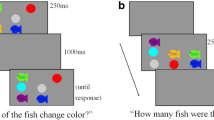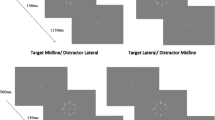Abstract
Considerable evidence has indicated that adults can exert top-down control to avoid distraction by salient-but-irrelevant stimuli. However, relatively little research has explored how this ability develops across the lifespan. In the present study, we therefore assessed how well children can control the capture of spatial attention. Children (M age = 4.2 years) and adults (M age = 21.5 years) searched for target “spaceships” of a specific color while trying to ignore salient precues that either matched or mismatched the target spaceship color. The results demonstrated that children are, in fact, more vulnerable to capture by irrelevant stimuli than are adults, even after accounting for children’s overall cognitive slowing.




Similar content being viewed by others
References
Atkinson, J., & Braddick, O. (2012). Visual attention in the first years: Typical development and developmental disorders. Developmental Medicine and Child Neurology, 54, 589–595.
Bacon, W. F., & Egeth, H. E. (1994). Overriding stimulus-driven attentional capture. Perception & Psychophysics, 55, 485–496. doi:10.3758/BF03205306
Belopolsky, A. V., Schreij, D., & Theeuwes, J. (2010). What is top-down about contingent capture? Attention, Perception, & Psychophysics, 72, 326–341. doi:10.3758/APP.72.2.326
Bernstein, J. (2012, September 3). Liking the child you love. Psychology Today. Retrieved from www.psychologytoday.com/blog/liking-the-child-you-love/201209/helping-children-and-teens-distractibility
Cepeda, N. J., Kramer, A. F., & Gonzalez de Sather, J. C. M. (2001). Changes in executive control across the life span: Examination of task-switching performance. Developmental Psychology, 37, 715–730.
Deltour, L., Barathon, M., Quaglino, V., Vernier, M.-P., Despretz, P., Boucart, M., & Berquin, P. (2007). Children with benign epilepsy with centrotemporal spikes (BECTS) show impaired attentional control: Evidence from an attentional capture paradigm. Epileptic Disorders, 9, 32–38.
Fisher, A. V., Godwin, K. E., & Seltman, H. (2014). Visual environment, attention allocation, and learning in young children: When too much of a good thing may be bad. Psychological Science, 25, 1362–1370. doi:10.1177/0956797614533801
Folk, C. L., Leber, A. B., & Egeth, H. E. (2002). Made you blink! Contingent attentional capture produces a spatial blink. Perception & Psychophysics, 64, 741–753. doi:10.3758/BF03194741
Folk, C. L., Remington, R. W., & Johnston, J. C. (1992). Involuntary covert orienting is contingent on attentional control settings. Journal of Experimental Psychology: Human Perception and Performance, 18, 1030–1044. doi:10.1037/0096-1523.18.4.1030
Fukuda, K., & Vogel, E. K. (2009). Human variation in overriding attentional capture. Journal of Neuroscience, 29, 8726–8733. doi:10.1523/JNEUROSCI.2145-09.2009
Gaspelin, N., Ruthruff, E., & Jung, K. (2014). Slippage theory and the flanker paradigm: An early-selection account of selective attention failures. Journal of Experimental Psychology: Human Perception and Performance, 40, 1257–1273. doi:10.1037/a0036179
Gaspelin, N., Ruthruff, E., Lien, M.-C., & Jung, K. (2012). Breaking through the attentional window: Capture by abrupt onsets versus color singletons. Attention, Perception, & Psychophysics, 74, 1461–1474. doi:10.3758/s13414-012-0343-7
Greenaway, R., & Plaisted, K. (2005). Top-down attentional modulation in autistic spectrum disorders is stimulus-specific. Psychological Science, 16, 987–994. doi:10.1111/j.1467-9280.2005.01648.x
Horowitz, T. S., Wolfe, J. M., Alvarez, G. A., Cohen, M. A., & Kuzmova, Y. I. (2009). The speed of free will. Quarterly Journal of Experimental Psychology, 62, 2262–2288. doi:10.1080/17470210902732155
Kail, R. V. (1991). Developmental change in speed of processing during childhood and adolescence. Psychological Bulletin, 109, 490–501.
Kail, R. V., & Ferrer, E. (2007). Processing speed in childhood and adolescence: Longitudinal models for examining developmental change. Child Development, 78, 1760–1770.
Leclercq, V., & Siéroff, E. (2013). Development of endogenous orienting of attention in school-age children. Child Neuropsychology, 19, 400–419.
Lien, M.-C., Gemperle, A., & Ruthruff, E. (2011). Aging and involuntary attention capture: Electrophysiological evidence for preserved attentional control with advanced age. Psychology and Aging, 26, 188–202. doi:10.1037/a0021073
Lien, M.-C., Ruthruff, E., Goodin, Z., & Remington, R. W. (2008). Contingent attentional capture by top-down control settings: Converging evidence from event-related potentials. Journal of Experimental Psychology: Human Perception and Performance, 34, 509–530. doi:10.1037/0096-1523.34.3.509
Lien, M.-C., Ruthruff, E., & Johnston, J. C. (2010). Attentional capture with rapidly changing attentional control settings. Journal of Experimental Psychology: Human Perception and Performance, 36, 1–16. doi:10.1037/a0015875
Mason, D. J., Humphreys, G. W., & Kent, L. (2004). Visual search, singleton capture, and the control of attentional set in ADHD. Cognitive Neuropsychology, 21, 661–687.
Oh-Uchi, A., Kawahara, J., & Sugano, L. (2010). Attentional capture and meta-attentional judgment: A study of young children, parents, and university students. Psychologia, 53, 114–124.
Theeuwes, J. (2010). Top-down and bottom-up control of visual selection. Acta Psychologica, 135, 77–99. doi:10.1016/j.actpsy.2010.02.006
Waters, A. M., Lipp, O. V., & Spence, S. H. (2004). Attentional bias toward fear-related stimuli: An investigation with nonselected children and adults and children with anxiety disorders. Journal of Experimental Child Psychology, 89, 320–337.
Williams, B. R., Ponesse, J. S., Schachar, R. J., Logan, G. D., & Tannock, R. (1999). Development of inhibitory control across the life span. Developmental Psychology, 35, 205–213.
Wolfe, J. M. (1994). Guided Search 2.0: A revised model of visual search. Psychonomic Bulletin & Review, 1, 202–238. doi:10.3758/BF03200774
Author information
Authors and Affiliations
Corresponding author
Rights and permissions
About this article
Cite this article
Gaspelin, N., Margett-Jordan, T. & Ruthruff, E. Susceptible to distraction: Children lack top-down control over spatial attention capture. Psychon Bull Rev 22, 461–468 (2015). https://doi.org/10.3758/s13423-014-0708-0
Published:
Issue Date:
DOI: https://doi.org/10.3758/s13423-014-0708-0




